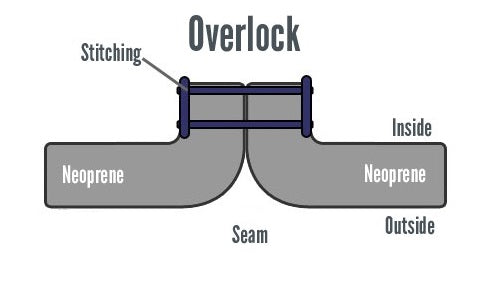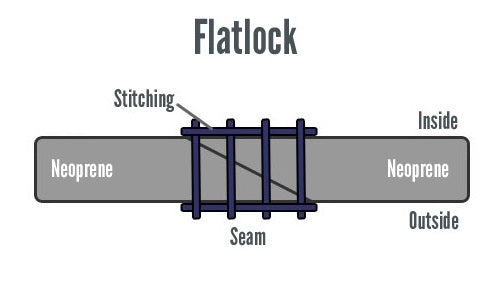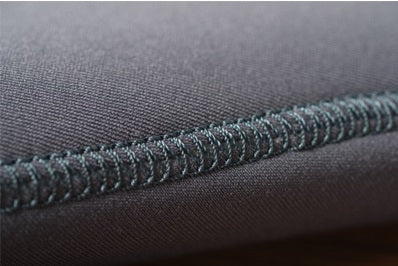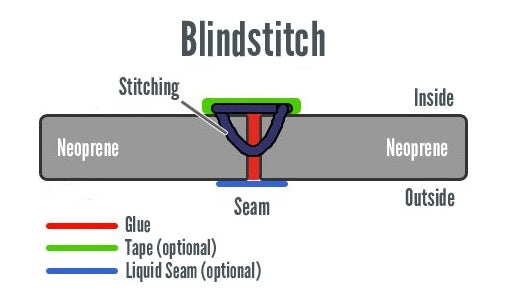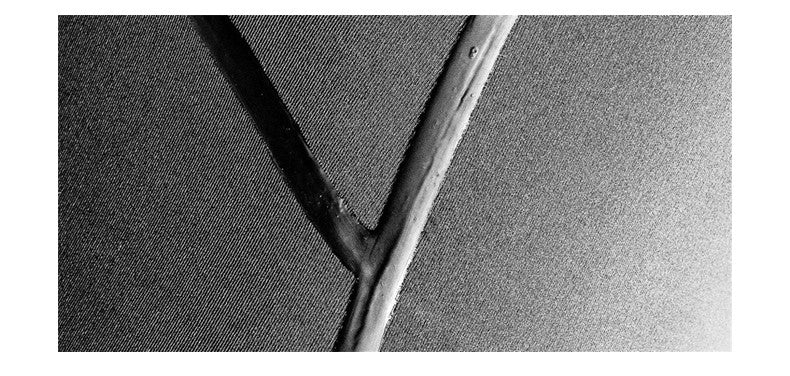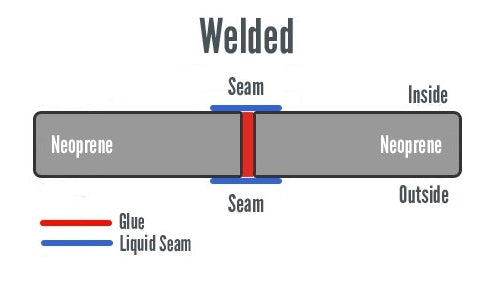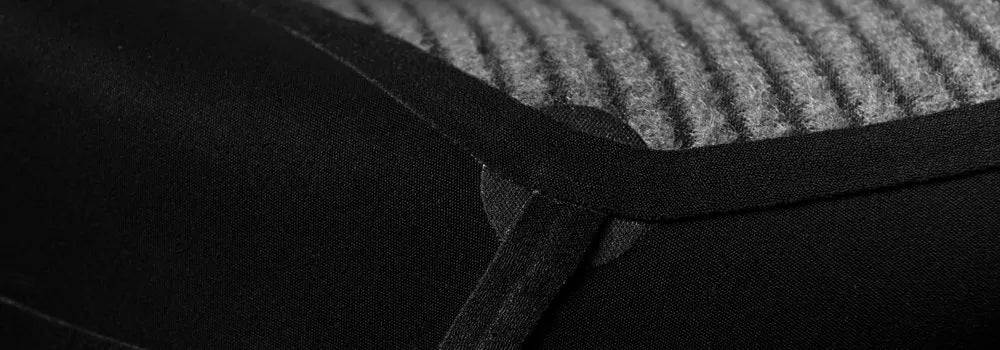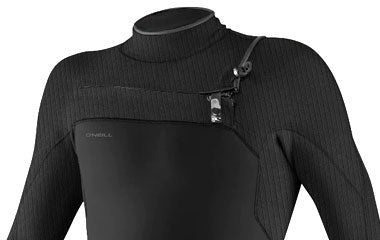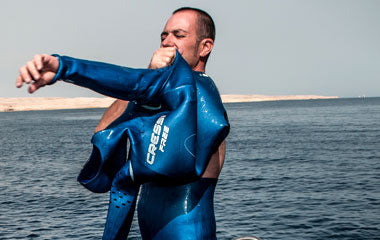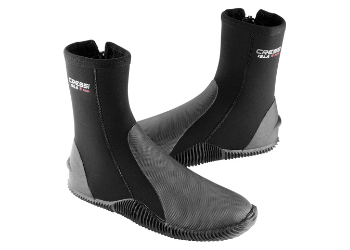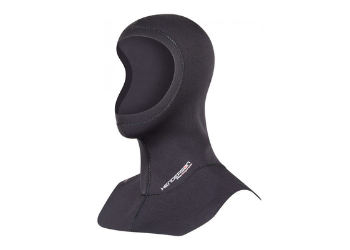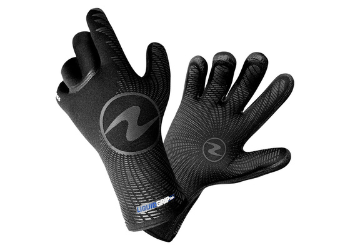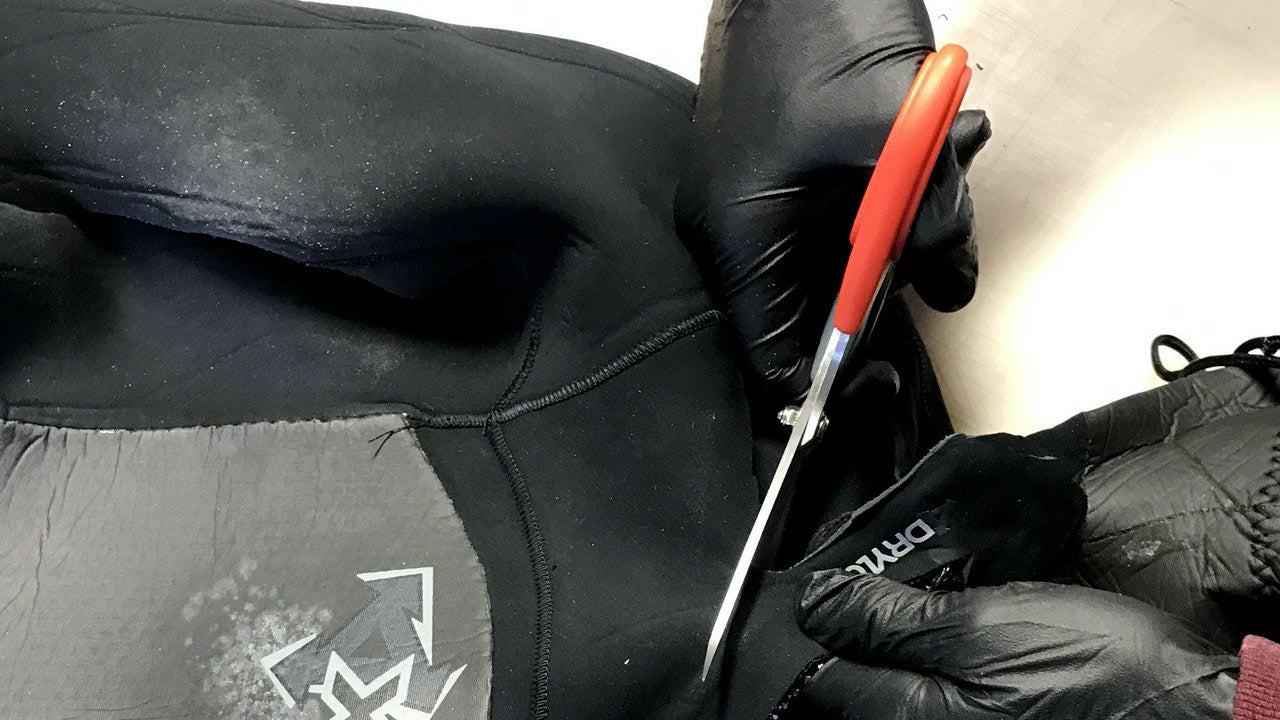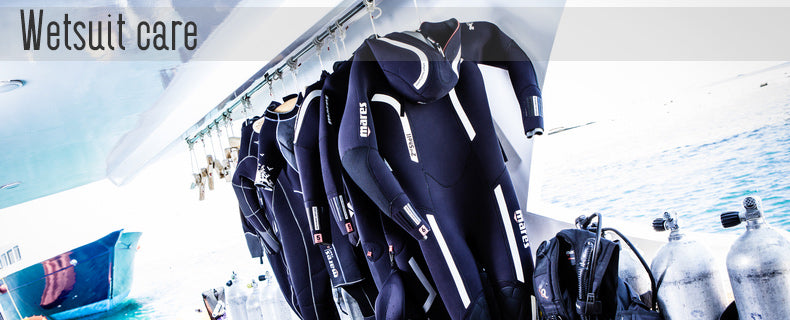With the wide array of wetsuits available these days, choosing the right one can seem a little daunting at first. You need to decide on a style, go through all the features, materials and suit construction details, select the proper thickness and find the right fit. To help you navigate through the process and choose a suit that will be ideal for your needs, we have put together this step-by-step guide with everything you'll need to know when making your decision.
How Wetsuits Work
Your wetsuit is not meant to keep you entirely dry. In fact, it works by trapping a thin layer of water between your skin and the suit. The water is then warmed up by your body heat. Neoprene, the material used in making wetsuits, contains many tiny air bubbles and provides the insulation against the colder water outside the suit. The thicker the neoprene, the warmer you will be. It is also essential that the wetsuit fits properly - not loose or baggy. Otherwise, cold water will constantly flush the warm water out. While a quality wetsuit is quite an investment, it will greatly enhance the quality of your dive and even keep you safe from hypothermia and other conditions related to cold water exposure.
Choosing a Wetsuit by Activity
While you can use the same wetsuit for different watersports, you should know that many suits are tailored for a specific activity, as different aquatic pursuits have different requirements. So, when choosing a wetsuit think what your primary sport is - will you mostly use the suit for diving, swimming, surfing or some other activity? This will dictate some of the features you should look for.
Wetsuits for scuba divers are usually made with warmth and durability in mind. Manufacturers use denser neoprene that can stand up to changes in pressure as you descend deeper underwater. This does make the wetsuit stiffer, but since you don’t move around a whole lot on a dive, mobility is less of a priority. Additionally, diving wetsuits often come with double lining to withstand abrasion from weights and all the other gear.
SHOP DIVING WETSUITS
Wetsuit Thickness
In order to choose the right wetsuit thickness, there a few questions you need to consider first.
How Is the Wetsuit Thickness Measured?
Wetsuit thickness is measured in millimeters and can be represented with one, two, or three numbers separated by a slash. The first number (X) represents the thickness of the neoprene in the torso area or the thickness of the whole suit, if it’s the only number. The second number (Y) represents the thickness of the neoprene in the extremities (or just the legs if there is a third number), and the third number (Z) represents the neoprene thickness in the arms. The neoprene in the torso area is usually the thickest, this helps to maintain your core body heat. The thinner neoprene is used for your extremities since you need more flexibility there.

What Factors Do I Need to Consider When Choosing Wetsuit Thickness?
Activity
You need to think about what you will be doing in the water. Will you be moving a lot (the more active you are, the more heat your body produces)? Are you going to spend most of your time underwater or on the surface (the body loses heat much faster in water than in air)? The recommended suit thickness for a given water temperature will differ depending on what sport you are into - for active surface sports, such as surfing, you can normally use a thinner suit than for scuba diving, for example.
Water Temperature
This one is the main factors and the most obvious one – in colder water you need a thicker wetsuit. If you are choosing a suit for diving, you also need to think about diving depth, as the deeper you dive, the colder the water gets in most parts of the world. Moreover, the pressure of the water will compress the the tiny air bubbles in the neoprene, decreasing the wetsuit efficiency.
Cold Sensitivity
How quickly do you usually get cold? Some people naturally feel colder than others in the same environment. Part of the reason for this is that different people have different “normal” body temperatures. Women also often report that they feel colder than men. So if you don’t handle cold well, consider wearing a few extra millimeters.
Wetsuit Style
In addition to neoprene thickness, the cut of a suit will also dictate how warm it will keep you. Shorties or springsuits are ideal for hot summer days. John\Jane wetsuits are great if you want more versatility, as you can sport the sleeveless suit when the weather is balmy and add the jacket when you need a bit extra warmth. Full suits that cover the entire body except for the hands, feet, and head are usually used in cool to cold water. However, because full suits come in a variety of thicknesses, you’ll find use for them in temperatures as low as 40 degrees (5 C), and as high as 70 degrees (21 C). Here is a more detailed breakdown of the main wetsuit types with pictures and best use scenarios.
Wetsuit Jacket
A wetsuit jacket (wetsuit top) is exactly what it sounds like, it covers you from the waist upwards, and can have either short or long sleeves. Commonly made from 0.5 mm to 2 mm thick neoprene, jackets are perfect for warm, yet windy locations, or cold early mornings, when a little extra warmth is needed. You can pair the top with boardshorts, bikini bottom, or neoprene pants. The jacket can also come as a part of the two-piece suit, combined with a John/Jane wetsuit.
SHOP ALLWetsuit Vest
Wetsuit vest is basically the same as wetsuit top, minus the sleeves. Vests are normally made from thin neoprene (1-2 mm), and, when worn alone, don’t keep you warm. They do, however, provide protection against UV rays or rashes, and do not restrict the range of motion in the shoulder area, which is important if you are into surfing or kayaking. Some wetsuit vests come with hoods and can be layered under or over a fullsuit for extra warmth in cold water.
SHOP ALLWetsuit Bottoms
Wetsuit bottoms are neoprene shorts or pants that offer additional warmth in warmer waters.
SHOP ALLSpringsuit
Springsuits, also called shorties, are often identified by their short legs. They can have short or long arms and are typically no more than 3 mm in thickness. In addition to UV protection, springsuits do offer some thermal protection, at the same time providing flexibility in two key stretch zones: knees and elbows (for a short sleeve version). They are still worn predominantly in warm waters and during transitional seasons, such as spring and autumn (hence the name).
SHOP ALLFullsuit
Fullsuit is the most common type of wetsuit for divers. It covers the entire body except for the hands, feet, and head. Made for cool to cold water, these suits can be found in many different thicknesses, ranging from 2 mm to 9 mm. What’s more, there are split-thickness wetsuits, designed to optimize flexibility and warmth by adjusting thickness depending on where it will be on the body. You can expect to find the thicker material in your non-stretch panels, particularly around your core. The thinner parts will be present in your high-stretch zones - typically shoulders, elbows, and knees. Depending on the water temperature, you may also need booties, gloves, and a hood to accompany the suit. Some fullsuits come with an attached hood for extra warmth. The benefit of an attached hood is that it will be more watertight than a detachable hood, but the drawback is that it will always be there whether you need it or not. All in all, because fullsuits come in a variety of thicknesses, you’ll find a use for them in temperatures as low as 40 degrees (5 C), and as high as 70 degrees (21 C).
Short Sleeve Fullsuit
Short sleeve fullsuit is a wetsuit with full-length legs, and arms that stop before the elbow. It is commonly made with a mix of 3 mm and 2 mm neoprene and is great if you are looking for extra flexibility in the arms. Since these suits are recommended for 60-70 F (16-21 C) temperature range, in most cases, you won't need any additional accessories, such as gloves or hoods, with this one.
John/Jane Wetsuit
John/Jane wetsuits can have full or short legs but are always sleeveless. Such a configuration is designed to keep your vitals warm while leaving your arms uncovered (great for easy paddling). John/Jane wetsuits are often sold in combination with a jacket. In this case, the two pieces of wetsuit overlap in the core providing extra thermal protection.
Wetsuit Construction
Wetsuit construction peculiarities such as the type and quality of seams and lining will affect the warmth of the suit as well.
Seams
Stitching is one of the most important factors in wetsuit construction. Good stitching can make a suit more comfortable, durable, and warm. Cheap stitching, on the other hand, can chafe your skin, allow water to seep in, and may even unravel. So, let’s look at the different types of stitching used in wetsuit manufacturing.
This method is the simplest way of stitching. The two edges of neoprene panels are simply folded up and stitched together. This method drastically reduces the flexibility of the seam and is least effective at keeping water out. It also leaves a bulge on the inside of the wetsuit, which can be uncomfortable and result in chafing. Nowadays, overlock stitching is not used on quality wetsuits, and would only be found on cheaper suits.
Zippers
A zipper is another important part of wetsuit construction. There are different quality zippers, and generally when you pay more you’ll get a long-lasting, stronger zipper that is easier and smoother to zip up. Another thing to look for is a thin layer of neoprene added between the zipper and your skin, it will help you keep excess water from coming in direct contact with your skin. Last but not least, you will need to decide where you want the zipper to be located.
Back zippers are most commonly used in wetsuits. They normally start at the base of the spine and go all the way up to the back of the collar. Such a long zip creates a large opening, which makes it easier to get in and out of the suit. Most back zips also come with a long pull tab which allows them to be reached easily to zip up or down. The downsides of back zip wetsuits include reduced flexibility along the spine and more opportunities for water to flush through.
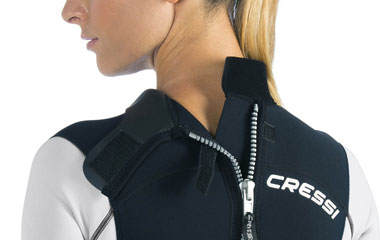
Neoprene and Lining
Neoprene
As we have mentioned before, neoprene is basically an elastic synthetic rubber with very good insulation properties thanks to millions of microscopic bubbles (the micro cells) trapped inside of the material. It was first used in wetsuit construction back in the early 1970s. The correct chemical name for this material is actually polychloroprene but after DuPont called it “neoprene”, the name stuck. Since then the material has changed quite a bit - it has become more flexible, warmer, and more durable. Nowadays, there are many different types of neoprene (often under different trade names) which are produced for various uses. For example, surf wetsuits are used on the surface of the water and need to be lightweight and stretchy, whereas dive wetsuits are used underwater and must be able to hold their thickness (not significantly compress with the increase in pressure) over the extended life of the wetsuit.
With that said, neoprene, being based on oil, is not the most eco friendly material out there. What’s more, some people are allergic to neoprene itself or to the substances used in its production. For these reasons, wetsuit manufacturers have started developing various neoprene alternatives.
Neoprene Alternatives
As wetsuit manufacturers become more aware of their impact on the environment, the processes and technologies they use are becoming more eco-friendly by the day. The first convincing technology to replace petroleum derivatives was Geoprene, a material made from limestone. Nowadays, there are many different more environmentally friendly neoprene alternatives, such as Japanese Yamamoto neoprene; Naturalprene; Bioprene - a version of limestone neoprene, made from seashells; and finally, Yulex, a plant-based neoprene alternative.
Lining
Another thing you need to consider is wetsuit lining. Most wetsuits are made from what is termed "double lined neoprene". This means that the neoprene rubber is laminated to a certain lining material on both sides. Nylon and spandex are among the most commonly used lining fabrics. They are extremely durable, which helps to protect the more fragile wetsuit material from damage. The two main downsides of using double lined suits are reduced flexibility and increased heat loss above the water (due to the effect called evaporative cooling).
To somewhat mitigate these problems Many brands have developed their own proprietary fabrics for internal lining. The fibers in these fabrics are usually made of polyester and contain large amounts of trapped air, which is one of the best insulation materials. Besides that, fibers are light, they don’t suck in water, dry quickly and are pretty stretchy. A few examples of these are Rip Curl’s Flash lining, Billabong’s has Drymax, Patagonia’s merino wool and recycled polyester fibers, etc.
There are also single lined and unlined suits. In single lined wetsuits a closed cell neoprene is only lined on the inside for comfort and warmth. The outside has a smooth skin appearance that absorbs heat quickly and does not allow the wind to penetrate the suit.
Unlined (smoothskin / superskin / open-cell) suits usually have a smooth or grained surface on the outside and a porous cell neoprene surface on the inside. They are extremely soft, elastic and comfortable, but are best suited for expert competitive freedivers and triathletes. The downside of this type of wetsuits is that they are very delicate and fragile, especially prone to being torn by fingernails when getting in and out of a suit. Thus, they must be used correctly in order to prevent damage to the wetsuit and ensure that it stays in great condition for a long time.
Wetsuit Extras
There are a few other useful features you may want to look for in a wetsuit.
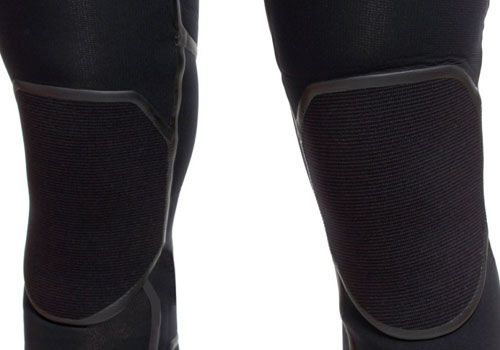
Knee and Elbow Pads
Some wetsuits come with the knee and/or pads that serve to provide extra protection to high wear areas. These pads can be integrated (sewn in) or laminated (glued on to the neoprene).
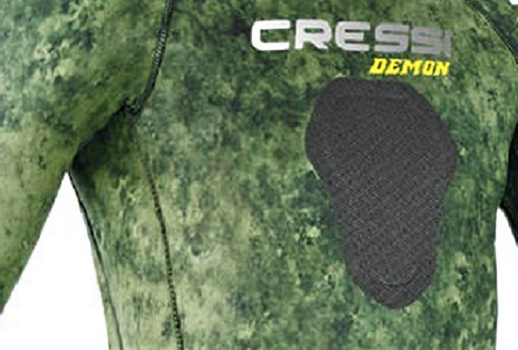
Chest Pad
A chest pad is a useful feature for spearfishermen. It is designed to protect the hunter’s chest when loading a speargun with rubber bands and to prevent the slipping of the gun when charging it.
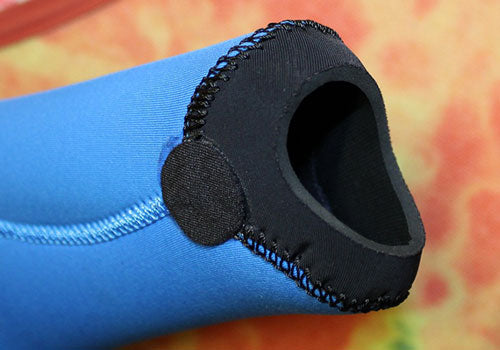
Wrist Seals
Wrist and ankle seals (usually an extra piece of thin rubbery membrane on the end of wetsuit sleeves or leg parts) help to minimize flushing and keep you warmer.
Wetsuit Temperature Chart for Divers
Wetsuit Temperature Chart for Surface Water Sports
Please note: For cold air temperatures, more wind, an activity with less movement or if you get cold easily, consider a thicker wetsuit.
Wetsuit Accessories
Once you have chosen your wetsuit, it is wise to consider getting some accessories as well. With the right wetsuit accessories, such as boots, hood and gloves, you will be able to upgrade your suit with the seasons, and keep your kit flexible in changeable weather.
Wetsuit Fit
Once you know what kind of suit you want, you still need to make sure it will fit you properly. Fit is crucial to ensure good mobility and to prevent heat loss. If the wetsuit is too loose, the water will flush through it, reducing the suit’s thermal effectiveness. On the other hand, a wetsuit that’s too tight can hinder your movement or restrict breathing. The right fitting suit should have no baggy spots or large wrinkles in the arms and legs, it should be snug in all areas but not uncomfortably tight.
Sizing differs between brands, and some will offer tall or short sizes. Make sure to check the sizing charts specific to each manufacturer and suit model, and take your measurements to select the correct size.
If you have any concerns about the fit or can’t find the proper size in the off-the-rack selection, there is the option of a custom-made wetsuit. A number of companies offer custom service. The process involves supplying a complete set of your specific measurements, and a custom suit will be made just for you. Although it’s the best way to ensure the correct fit, custom-made suits usually have a considerably higher price tag.





